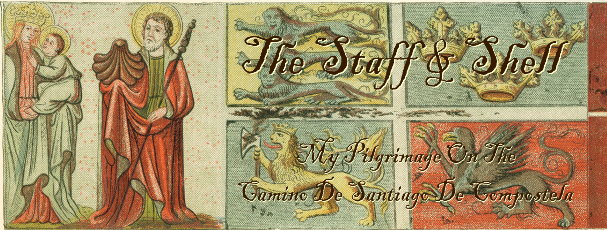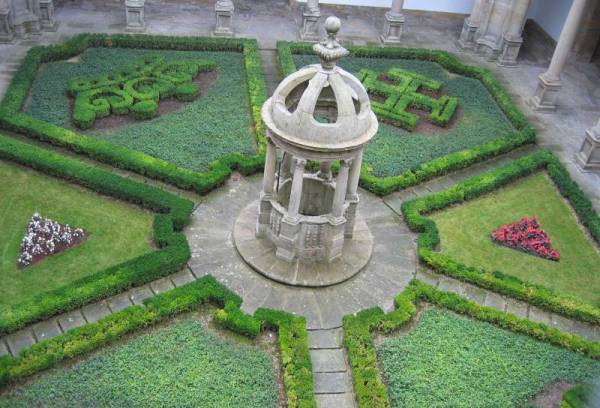
In the Christian tradition, the earliest pilgrims went to places associated with the life and death of Christ. After a while, the graves of early Christian martyrs were added. People believed that if they saw or touched a sacred relic some of the divine energy in that relic would be transferred to them.
Sacred relics and objects that were promoted as sacred relics were spread out over Europe. A relic was usually some part or all of the body of a holy person or something that was in contact with the holy person. It might be the jaw of Saint Coloman which is a sacred object in the Austrian monastery at Melk, or a piece of the cross on which Christ was crucified. Almost every community suffered from ‘relic envy”. Relics brought pilgrims and pilgrims brought money and money brought power and power brought more relics.
Of course, not everyone was convinced. Saint Augustine believed that what was holy could not be localized to a specific place, which meant that a pilgrimage was a waste of time and money, but that was a minority view.
The word was out that when the world came to an end the holy person would return to earth and collect all of his or her body parts and at the same time decide whose spirit would return with them to heaven.
If you were a believer and rich you tried to get buried near an important relic. You wanted to be in a convenient spot when the saint came back to earth and was deciding who would return with him to heaven.
Rome was the epicenter of the relic trade. You could purchase one of the loaves of bread or a fish from the miracle of the loaves and fishes, a table setting from the Last Supper or a thorn from the crown of thorns.
It’s easy to laugh at these things and see many of them as the fakes they were, but their effect on people was real. If your belief in an object’s power results in your cure, then by definition, it is a miraculous object.
ON THE ROAD TO COMPOSTELA
Throughout most of history there were only two reasons for traveling - you were going to war or making a pilgrimage. In either case you gave up the life you were living and went off on a new and usually dangerous journey - a journey that often went on for years.
Every church was required to have a relic even if it was only a local saint. But certain relics were understood to be much more powerful than others and those were the ones you wanted to get to.
Power was based on hierarchy - Christ of course was at the top so visiting Jerusalem would be most effective. But in terms of time and expense Jerusalem was unreachable for most people. It was also under the control of the Turks which made the journey extremely dangerous. Next came the Apostles Peter and Paul who were buried in Rome, which made Rome first runner up. Rome was easier to get to but often in political turmoil. You could never be sure of what would be going on in Rome when you finally got there.
Peter and Paul were followed by the other Apostles with James the Greater being of particular importance because he had actually been with Christ. Santiago de Compostela in the northwest of Spain, where the great cathedral was said to contain the complete remains of Saint James was your best shot. It was near enough to the great cities of Europe to be reachable, yet far enough away to be exotic and exciting.
Santiago was at the very edge of the known world, yet in the middle of the Middle Ages over half a million people made the trip every year. It offered Christians living in Europe the opportunity to make contact with someone who had actually known Jesus.
Another reason to go on a long pilgrimage was all the powerful relics that you would encounter along the way. Since every church needed to have relics, it would be to a pilgrim’s benefit to stop at every church on the road and offer a prayer.
THE LEGEND
The legend of Santiago de Compostela deals with James the Greater who was the brother of John the Evangelist. Both were fishermen on the Sea of Galilee. One day Jesus passed by and invited the brothers to join him and they did.
After the death of Jesus, James left Jerusalem with instructions to spread Christianity in Spain. Having very little success with this mission he returned to Jerusalem where he was beheaded by the Roman governor.
His disciples recovered his head and his body and placed them in a stone boat that had neither a rudder nor sails yet somehow ended up on the northwest coast of Spain.
As the boat came ashore the first miracle associated with Saint James took place. A bridegroom riding along the beach lost control of his horse and was thrown into the surf. Instead of drowning he emerged from the waves covered with scallop shells. The rider’s safe return from the deep is credited to the intervention of the Saint. And ever since, the image of the scallop shell has been associated with James.
The followers of Saint James then buried his body in an ancient Roman cemetery where it rested unnoticed for 800 years. At some point during this period the cemetery was abandoned and slipped back to a grass covered field.
Then in the year 812, a star appeared above the field accompanied by the sounds of heavenly music. A hermit saw the star, heard the music and followed them to the body of St. James. He reported his discovery to the local bishop who built a chapel over the grave. The site became known as Santiago de Compostela which means “St James of the Field of Stars”.
What is important about this story is not what historians have been able to prove or not prove, but how it has affected the hearts of the pilgrims who have made the journey.






























No comments:
Post a Comment